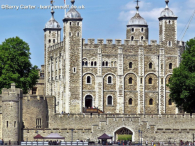





Docklands and the Thames,
Victoria Park to Paternoster
Square. Take a nostalgic
trip back to the East End in
the 1950’s or a stroll around
the Square Mile of the City
of London. It’s all here at
barryoneoff.co.uk
Copyright 2002 - 2024 ©Barry Carter. All rights reserved
TOWER HAMLETS
A Very Brief History
The London Borough of Tower Hamlets, as it is known today, came into being in 1965. It covers a very large part of East London as a result of merging three smaller Metropolitan Boroughs of Bethnal Green, Poplar, and Stepney into one larger area. It lies on the North side of the River Thames and incorporates the redeveloped financial district known as Docklands. There have been people living in the area for centuries; long before the Romans came and founded the City of London, which is just a short distance away. It is not known for sure whether this was a permanent stone age settlement or not. The soil though, would have been ideal for farming and so makes it more than likely that they were actually the first local residents. It has been home to many immigrants over the years, due to it's close proximity to the docks, including the Huguenots and the Jews. Today’s population is mainly Muslim, having the highest Islamic percentage than anywhere else in Britain. It has around 50 Mosques and Islamic centres including The East London Mosque in Whitechapel, the largest in Britain.Population Explosion
Tower Hamlets lies east of the adjoining City of London and north of the Thames in East London. Hackney lies to the north and the River Lea acts as the border with Newham, another borough made up of combined smaller boroughs. The Isle of Dogs is formed from the entrances to long gone docks and the large meander of the Thames. The borough had a population of 304,900 in June 2016. The population has doubled in the past 30 years and is predicted to rise to 364,500 by 2026. A study made in 2017 by Trust for London and New Policy Institute showed that Tower Hamlets has the highest rate of poverty, child poverty, unemployment, and pay inequality of any London borough. I look around and see the young men and women driving cars, wearing designer clothes and top brand trainers, using hi tec smart phones and wonder how this can be true. But they are the experts, so it must be.Before the Romans
There is, obviously, no written history for this period in time, and very little archaeological evidence has survived or been found. It is, according to Kevin Kerrigan in his ‘History of Tower Hamlets’, a fact that around 200 years prior to the Roman invasion of 43 AD the area was part of the territory captured by the Belgic tribes. They had invaded in the second century BC. When the Romans came they chased these tribes to their capital town of Catuvellauni (now Colchester) where they defeated them. The town later became a colony for veteran Roman legionnaires who stayed here.



Hamlets Near The Tower
Christianity became the dominant religion over the years and the church became rich as well as powerful. As the wealth of the church grew so did the areas of land in it’s possession. The manor that included present day Tower Hamlets and Hackney came under possession of the church in the form of the Bishops of London. In 1078 William the Conqueror started the beginnings of the Tower of London with the construction of the White Tower to keep an eye on the City. In later years it was the settlements, or hamlets, around the Tower that provided the soldiers to man the fortress. These ‘Tower Hamlets’ covered the area of today’s borough and a part of Hackney. If you are a resident of Tower Hamlets you can enter the Tower for the sum of just one pound.

















